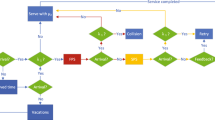Abstract
Power saving and Quality of Service (QoS) are the two significant aspects of Long Term Evolution-Advanced (LTE-A) networks. DRX (“Discontinuous Reception”) is a mechanism, commonly exercised to enhance the power saving competency of a User Equipment (UE) in LTE-A networks. In this paper, based on the kind of traffic running at the UE, a new appliance is proposed to switch the DRX mechanism from the power active state to the power saving state and vice versa. We mathematically investigate this switching technique in DRX mechanism using the M[X]/G/1 vacation queue system with N-policy. Various performance and energy metrics are obtained and examined numerically. Further, the optimal value of N as well as the maximum number of DRX cycles, are computed to obtain the minimal amount of power consumption. This study concludes the selection guidelines for choosing the optimal values of N and the maximum number of DRX cycles.







Similar content being viewed by others
References
Wang K, Li X, Ji H, Du X (2016) Modeling and optimizing the LTE discontinuous reception mechanism under self-similar traffic. IEEE Trans Veh Technol. https://doi.org/10.1109/2328232
Hamdoun H, Loskot P, O’Farrell T, He J (2012) Survey and applications of standardized energy metrics to mobile networks. Ann Telecommun-Anns Télécommun 67(3–4):113–123
Vallina-Rodriguez N, Crowcroft J (2013) Energy management techniques in modern mobile handsets. IEEE Commun Surv Tutor 15(1):179–198
Yang SR, Lin YB (2005) Modeling UMTS discontinuous reception mechanism. IEEE Trans Wirel Commun 4(1):312–319
Yang SR, Yan SY, Hung HN (2007) Modeling UMTS power saving with bursty packet data traffic. IEEE Trans Mob Comput 6(12):1398–1409
Sahinoglu Z, Tekinay S (1999) On multimedia networks: self-similar traffic and network performance. IEEE Commun Mag 37(1):48–52
Alouf S, Altman E, Azad AP (2008) Analysis of an M/G/1 queue with repeated inhomogeneous vacations with application to IEEE 802.16e power saving mechanism. In: Proceedings of IEEE 5th international conference on quantitative evaluation of systems, (QEST’08), pp 27–36
Dimitriou I (2014) A queueing system with probabilistic inhomogeneous vacations for modeling power-saving in wireless systems with retransmissions. In: Proceedings of the information sciences and systems 2014. Springer, Cham, pp 217–228
Dimitriou I (2014) A modified vacation queueing model and its application on the Discontinuous Reception power saving mechanism in unreliable Long Term Evolution networks. Perform Eval 77:37–56
Dimitriou I (2016) Queueing analysis of the DRX power saving mechanism in fault-tolerant 3GPP LTE wireless networks. Ann Oper Res 239(2):521–552
Anisimov A, Andreev S, Lokhanova A, Turlikov A (2011) Energy efficient operation of 3GPP LTE-advanced and IEEE 802.16 m downlink channel. In: Proceedings of the IEEE 3rd international congress on ultra modern telecommunications and control systems and workshops (ICUMT), pp 1–5
Azad AP, Alouf S, Altman E, Borkar V, Paschos GS (2011) Optimal control of sleep periods for wireless terminals. IEEE J Sel Areas Commun 29(8):1605–1617
Hwang E, Kim KJ, Son JJ, Choi BD (2009) The power saving mechanism with binary exponential traffic indications in the IEEE 802.16 e/m. Queueing Syst 62(3):197–227
Mancuso V, Alouf S (2012) Analysis of power saving with continuous connectivity. Comput Netw 56 (10):2481–2493
Yeh JH, Chen JC, Lee CC (2009) Comparative analysis of energy-saving techniques in 3GPP and 3GPP2 systems. IEEE Trans Veh Technol 58(1):432–448
Yu YP, Feng KT (2012) Traffic-based DRX cycles adjustment scheme for 3GPP LTE systems. In: Proceedings of the IEEE 75th vehicular technology conference (VTC), pp 1–5
Ke JC, Huang HI, Chu YK (2010) Batch arrival queue with N-policy and at most J vacations. Appl Math Model 34(2):451–466
Tian N, Zhang ZG (2006) Vacation queueing models—theory and applications. Springer, New York
Zhou L, Xu H, Tian H, Gao Y, Du L, Chen L (2008) Performance analysis of power saving mechanism with adjustable DRX cycles in 3GPP LTE. In: Proceedings of the IEEE 68th vehicular technology conference (VTC), 2008, pp 1–5
Fowler SA, Mellouk A, Yamada N (2013) LTE-advanced DRX mechanism for power saving. Wiley, New York
Wang K, Li X, Ji H (2014) Modeling 3GPP LTE advanced DRX mechanism under multimedia traffic. IEEE Commun Lett 18(7):1238–1241
Lee HW, Lee SS, Chae KC (1994) Operating characteristics of m[X]/g/1 queue with N-policy. Queueing Syst 15(1–4):387–399
Ke JC, Chu YK (2006) A modified vacation model M[X]/g/1 system. Appl Stoch Model Bus Ind 22(1):1–16
Chaudhry ML, Templeton JGC (1983) A first course in bulk queues. Wiley, New York
Cox DR (1955) The analysis of non-Markovian stochastic processes by the inclusion of supplementary variables. Math Proc Camb Philos Soc 51(3):433–441. Cambridge University Press
Gross D, Harris CM (2004) Fundamentals of queueing theory, 3rd edn. Wiley, New York
Choudhury G, Ke JC, Tadj L (2009) The N-policy for an unreliable server with delaying repair and two phases of service. J Comput Appl Math 231(1):349–364
Bellman R (1956) Dynamic programming and Lagrange multipliers. Proc Natl Acad Sci 42(10):767–769
Azad AP (2011) Analysis and optimization of sleeping mode in wiMAX via stochastic decomposition techniques. IEEE J Sel Areas Commun 29(8):1630–1640
Baek S, Choi BD (2011) Analysis of discontinuous reception (DRX) with both downlink and uplink packet arrivals in 3GPP LTE. In: Proceedings of the 6th international conference on queueing theory and network applications, pp 8–16
Acknowledgements
Authors are thankful to the editor and two anonymous reviewers for their valuable suggestions and comments, which helped improve the paper to great extent.
Funding
This study received financial support from the Department of Telecommunications (DoT), India. Further, the first author would like to thank the Council of Scientific and Industrial Research (CSIR), India for providing her financial support through Senior Research Fellowship.
Author information
Authors and Affiliations
Corresponding author
Rights and permissions
About this article
Cite this article
Gautam, A., Choudhury, G. & Dharmaraja, S. Performance analysis of DRX mechanism using batch arrival vacation queueing system with N-policy in LTE-A networks. Ann. Telecommun. 75, 353–367 (2020). https://doi.org/10.1007/s12243-018-0659-y
Received:
Accepted:
Published:
Issue Date:
DOI: https://doi.org/10.1007/s12243-018-0659-y




